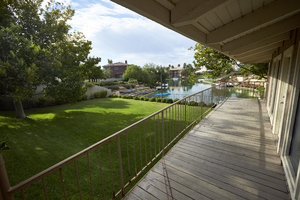Search the Special Collections and Archives Portal
Search Results

Landscaper working on West Sahara Avenue west of South Durango Drive, Las Vegas, Nevada: digital photograph
Date
2017-08-29
Archival Collection
Description
A landscaper trims a plant at The Residence at Canyon Gate multifamily housing along West Sahara Avenue west of South Durango Drive.
Image

Street signs on West Sahara Avenue near South Durango Drive, Las Vegas, Nevada: digital photograph
Date
2017-08-29
Archival Collection
Description
Street signs sit along West Sahara Avenue in The Lakes area near South Durango Drive. August 29, 2017 UNLV Libraries Special Collections / Aaron Mayes N36 °08.633' x W115 °17.283')
Image

Baycliff Creek apartments in The Lakes, Las Vegas, Nevada: digital photograph
Date
2017-08-29
Archival Collection
Description
The Baycliff Creek multi-family housing complex sits on Crystal Water Way just south of West Sahara Avenue in The Lakes area near South Durango Drive. August 29, 2017 UNLV Libraries Special Collections / Aaron Mayes N36 °08.517' x W115 °17.303')
Image

Baycliff Creek apartments in The Lakes, Las Vegas, Nevada: digital photograph
Date
2017-08-29
Archival Collection
Description
The Baycliff Creek multi-family housing complex sits on Crystal Water Way just south of West Sahara Avenue in The Lakes area near South Durango Drive. August 29, 2017 UNLV Libraries Special Collections / Aaron Mayes N36 °08.516' x W115 °17.309')
Image

Baycliff Creek apartments in The Lakes, Las Vegas, Nevada: digital photograph
Date
2017-08-29
Archival Collection
Description
The Baycliff Creek multi-family housing complex sits on Crystal Water Way just south of West Sahara Avenue in The Lakes area near South Durango Drive. August 29, 2017 UNLV Libraries Special Collections / Aaron Mayes N36 °08.482' x W115 °17.286')
Image

Sidewalks on West Lake North Drive in The Lakes, Las Vegas, Nevada: digital photograph
Date
2017-08-29
Archival Collection
Description
Sidewalks meander along West Lake North Drive just south of West Sahara Avenue in The Lakes development. August 29, 2017 UNLV Libraries Special Collections / Aaron Mayes N36 °08.477' x W115 °17.298')
Image

School bus on West Lake North Drive in The Lakes, Las Vegas, Nevada: digital photograph
Date
2017-08-29
Archival Collection
Description
A school bus makes a pick-up on West Lake North Drive just south of West Sahara Avenue in The Lakes development. August 29, 2017 UNLV Libraries Special Collections / Aaron Mayes N36 °08.482' x W115 °17.355')
Image

Homes on South Crystal Bay Drive in The Lakes, Las Vegas, Nevada: digital photograph
Date
2017-08-29
Archival Collection
Description
Typical housing found just south of West Sahara Avenue in The Lakes development. These homes sit on South Crystal Bay Drive. August 29, 2017 UNLV Libraries Special Collections / Aaron Mayes N36 °08.448' x W115 °17.366')
Image

Landscaping on West Lake North Drive in The Lakes, Las Vegas, Nevada: digital photograph
Date
2017-08-29
Archival Collection
Description
Lush, grass-heavy landscaping lines West Lake North Drive just south of West Sahara Avenue in The Lakes development. August 29, 2017 UNLV Libraries Special Collections / Aaron Mayes N36 °08.471' x W115 °17.350')
Image

Waterway in The Lakes, Las Vegas, Nevada: digital photograph
Date
2017-08-29
Archival Collection
Description
A facility operated by The Lakes Association on South Lake North Drive offers a view of the waterway that give The Lakes development its name. This area is just south of West Sahara Avenue near South Durango Drive. August 29, 2017 UNLV Libraries Special Collections / Aaron Mayes N36 °08.438' x W115 °17.244')
Image
Pagination
Refine my results
Content Type
Creator or Contributor
Subject
Archival Collection
Digital Project
Resource Type
Year
Material Type
Place
Language
Records Classification
